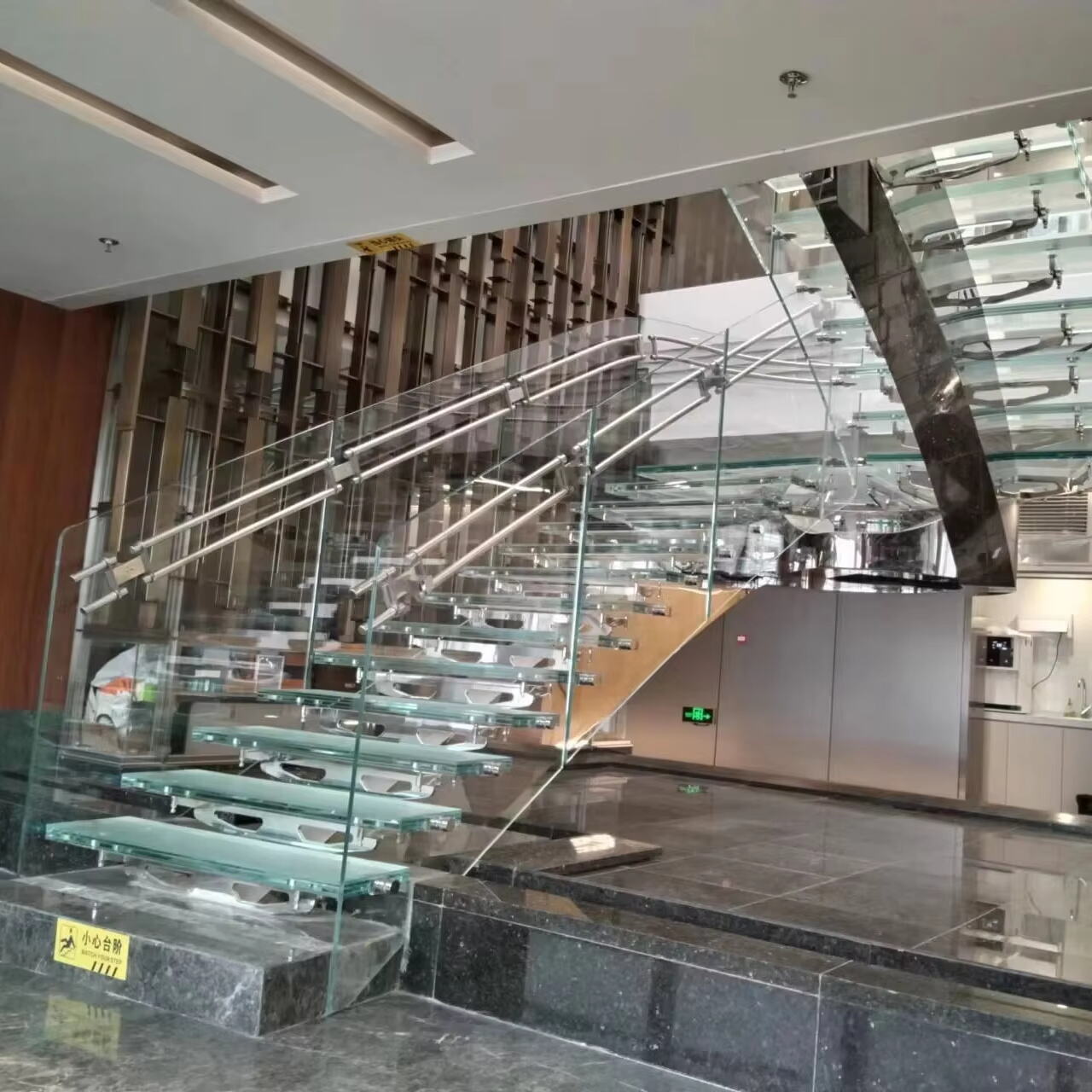เพิ่มความหลากหลายทางด้านความงามด้วยกระจกตกแต่ง
พื้นผิวและลวดลายแบบกำหนดเองสำหรับการออกแบบสมัยใหม่
พื้นผิวกระจกที่มีลวดลายและเนื้อผ้าแบบพิเศษได้รับความนิยมอย่างมากในวงการออกแบบในปัจจุบัน ช่วยให้พื้นที่ต่าง ๆ มีเอกลักษณ์เฉพาะตัวและดูโดดเด่นไม่ซ้ำใคร เมื่อสถาปนิกนำกระจกที่ผ่านกระบวนการต่าง ๆ เช่น การทรายเป่า การกัดกรด หรือกระจกลวดลายมาใช้ในอาคาร ก็สามารถเล่นกับแสงสว่างภายในพื้นที่นั้น ๆ ได้อย่างน่าทึ่ง ผู้คนชื่นชอบพื้นผิวที่มีลวดลายเหล่านี้ เนื่องจากเข้ากับเทรนด์การออกแบบภายในที่กำลังได้รับความนิยมในปัจจุบัน ทุกคนต้องการสิ่งที่มีความแปลกใหม่และสะดุดตา ตัวอย่างเช่น ผนังกระจกกัดกรดที่เราเห็นได้บ่อยขึ้นในสำนักงานช่วงหลัง มีบทบาทในการช่วยลดความแข็งกระด้างของแสงสว่าง ขณะเดียวกันก็ยังคงความเป็นส่วนตัวของพื้นที่ไว้ได้อย่างดี โครงการหนึ่งที่น่าสนใจคือ งานที่นักออกแบบร่วมมือกับผู้เชี่ยวชาญด้านกระจกเพื่อพัฒนาผนังกั้นแบบกัดกรดเฉพาะทางสำหรับอาคารสำนักงานใหญ่แห่งใหม่ ผลลัพธ์ที่ได้ยอดเยี่ยมทั้งในด้านความสวยงามและการใช้งานจริง กระจกที่มีองค์ประกอบเชิงตกแต่งยังคงมีบทบาทสำคัญในการออกแบบสถาปัตยกรรมสมัยใหม่ เนื่องจากมีความหลากหลายในการสร้างสรรค์โดยไม่ต้องแลกกับประสิทธิภาพการใช้งาน
การผสานองค์ประกอบศิลปะเข้ากับพื้นที่สถาปัตยกรรม
กระจกตกแต่งมีดีมากกว่าแค่หน้าตาดูดีเท่านั้น แท้จริงแล้วมันมีบทบาทสำคัญในงานออกแบบสถาปัตยกรรม เวลาที่มันสร้างจุดโฟกัสที่สะดุดตา จนคนจดจำได้ เมื่อสถาปนิกนำกระจกสีหรือกระจกที่มีสีสันมาใช้ในงานออกแบบ พวกเขาไม่ได้เพียงแค่ทำให้อะไรดูสวยงามขึ้นเท่านั้น แต่ยังเพิ่มองค์ประกอบเชิงวัฒนธรรมที่มีความหมายให้กับพื้นที่อีกด้วย การทำงานร่วมกับศิลปินและนักออกแบบที่มีทักษะสูง นำไปสู่การติดตั้งกระจกที่พิเศษมาก ซึ่งสามารถแสดงถึงค่านิยมขององค์กร หรือเล่าเรื่องราวเกี่ยวกับวัฒนธรรมท้องถิ่นได้ ตัวอย่างเช่น ร้านค้าเครือข่ายร้านเสื้อผ้าเจ้าหนึ่ง ที่เพิ่งติดตั้งหน้าต่างกระจกสีที่มีลวดลายใบไม้ในทุกสาขา เพื่อแสดงถึงความมุ่งมั่นต่อการปฏิบัติที่เป็นมิตรต่อสิ่งแวดล้อม สถาปนิกหลายคนกล่าวถึงว่า กระจกเชิงศิลปะสามารถเปลี่ยนบรรยากาศของอาคารโดยรวมได้อย่างไร โดยอ้างถึงโครงการชื่อดังที่องค์ประกอบกระจกเหล่านี้มีบทบาทสำคัญในการเปลี่ยนประสบการณ์ของผู้ใช้งานพื้นที่ไปอย่างสิ้นเชิง สถาปนิกที่เคยทำงานในโครงการเหล่านี้จะบอกกับทุกคนว่า การนำกระจกเชิงศิลปะมาใช้ในอาคาร ทำให้อาคารโดดเด่นในเชิงทัศน์ และสร้างสภาพแวดล้อมที่ผู้คนสามารถมีปฏิสัมพันธ์และเชื่อมโยงด้วย การผสานเช่นนี้แสดงให้เห็นอย่างงดงามว่า ศิลปะและการใช้งานสามารถทำงานร่วมกันได้อย่างลงตัวในสถาปัตยกรรมสมัยใหม่
การเพิ่มแสงธรรมชาติและการรับรู้เชิงพื้นที่สูงสุด
การจัดสรรแสงแดดให้มีประสิทธิภาพด้วยพื้นผิวโปร่งแสง
กระจกที่มีลักษณะโปร่งแสงช่วยกระจายแสงธรรมชาติให้ทั่วทั้งพื้นที่ได้อย่างยอดเยี่ยม ลดแสงสะท้อนที่รบกวนสายตา แต่ยังคงให้แสงสว่างเพียงพอภายในห้อง สิ่งที่ทำให้กระจกประเภทนี้มีความพิเศษคือ ความสามารถในการให้ทัศนวิสัยที่ดีโดยไม่ละเมิดความเป็นส่วนตัว ซึ่งเป็นเหตุผลว่าทำไมกระจกประเภทนี้จึงเหมาะสำหรับใช้ในบ้านพักอาศัยไปจนถึงอาคารสำนักงาน เมื่อสถาปนิกนำวัสดุก่อสร้างที่มีลักษณะกึ่งโปร่งใสนี้มาใช้ในแบบแปลนการออกแบบ พวกเขาสามารถสร้างสรรค์พื้นที่ที่มีความเปิดโล่ง แต่ยังคงความเป็นส่วนตัวในบางจุดได้อย่างลงตัว มีงานวิจัยที่น่าสนใจเกี่ยวกับการได้รับแสงแดดในที่ทำงาน โดยพบว่า คนที่ได้รับแสงธรรมชาติเพียงพอในระหว่างวันมักมีความสุขมากกว่าและมีระดับความเครียดที่ต่ำกว่าเมื่อเทียบกับผู้ที่อยู่ภายใต้แสงไฟเทียมตลอดทั้งวัน นี่จึงเป็นเหตุผลว่าทำไมนักออกแบบที่มีวิสัยทัศน์กว้างไกลจึงคำนึงถึงการเคลื่อนที่ของแสงภายในอาคารเสมอ ก่อนที่จะสรุปรายละเอียดแผนการก่อสร้างโครงการใหม่ ๆ
การสร้างความต่อเนื่องทางสายตาในแบบแปลนเปิด
พื้นที่แบบเปิดโล่งได้รับประโยชน์อย่างมากจาก กระจกตกแต่ง คุณสมบัติที่ช่วยให้ผู้คนรับรู้ถึงพื้นที่แตกต่างออกไป และรักษาการเชื่อมต่อทางสายตาตลอดทั้งบริเวณ เมื่อนักออกแบบติดตั้งผนังกระจกหรือระบบประตูเลื่อน ก็จะสร้างความรู้สึกเหมือนมีอุปสรรคทางกายภาพลดลง แม้ยังคงไว้ซึ่งโซนที่แยกจากกันอย่างเพียงพอเพื่อวัตถุประสงค์การใช้งานในที่ทำงานที่ความร่วมมือมีความสำคัญมากที่สุด ผลลัพธ์ที่ได้คือ ห้องดูกว้างขึ้นกว่าที่มีอยู่จริง ด้วยการเปลี่ยนผ่านอย่างราบรื่นจากส่วนหนึ่งไปยังอีกส่วนหนึ่ง ผู้เชี่ยวชาญด้านการออกแบบภายในหลายคนต่างชี้ให้เห็นว่าองค์ประกอบกระจกเหล่านี้สามารถปรับใช้ได้หลากหลายเพียงใด โดยทำงานได้ดีเท่าเทียมกันทั้งใน หน้าแรก สภาพแวดล้อมที่อยู่อาศัยและสถานที่ทำงาน ตัวอย่างเช่น ฉากกั้นห้องทำงานที่ทำจากกระจก สามารถกำหนดตำแหน่งที่ทำงานได้อย่างชัดเจน แต่ไม่บดบังทัศนวิสัยระหว่างแผนกต่างๆ ส่งเสริมให้เกิดปฏิสัมพันธ์ที่ดีขึ้นระหว่างพนักงาน การนำเอาองค์ประกอบกระจกประเภทนี้มาใช้ในแบบแปลนพื้นที่เปิดแบบทันสมัย ย่อมส่งผลให้พื้นที่เหล่านั้นมีประสิทธิภาพในการใช้งานและน่าดึงดูดมากยิ่งขึ้น

ความยั่งยืนผ่านกระจกตกแต่งที่ประหยัดพลังงาน
สารเคลือบที่ลดการถ่ายเทความร้อน (Low-E) และประโยชน์ของการป้องกันความร้อน
สารเคลือบ Low E ซึ่งย่อมาจากคำว่า low emissivity ช่วยเพิ่มประสิทธิภาพการใช้พลังงานในอาคารได้อย่างแท้จริง โดยพื้นฐานแล้ว สารเคลือบนี้จะช่วยสะท้อนแสงอินฟราเรดกลับออกไป จึงช่วยลดการถ่ายเทความร้อนผ่านกระจก ขณะที่ยังคงให้แสงที่ตามองเห็นสามารถส่องผ่านได้ตามปกติ มีงานวิจัยบางส่วนแสดงให้เห็นว่า การเปลี่ยนมาใช้กระจก Low E สามารถลดการใช้พลังงานได้ราว 30% เมื่อเทียบกับกระจกธรรมดา ผู้บริหารและเจ้าของอาคารที่มุ่งเน้นการพัฒนาอย่างยั่งยืนต่างเห็นว่าฉนวนประเภท่นี้มีคุณค่ามหาศาล เนื่องจากช่วยลดทั้งการปล่อยก๊าซคาร์บอนและค่าใช้จ่ายรายเดือน การติดตั้งกระจกที่มีสารเคลือบ Low E จึงเป็นทางเลือกที่มีเหตุผลสำหรับผู้ที่ต้องการให้อาคารมีประสิทธิภาพการใช้พลังงานสูงขึ้น และสอดคล้องกับแนวทางการก่อสร้างที่เป็นมิตรต่อสิ่งแวดล้อมที่กำลังได้รับความนิยมในอุตสาหกรรมในปัจจุบัน
การผสมวัสดุรีไซเคิลในกระบวนการผลิตกระจก
การนำวัสดุรีไซเคิลมาใช้ในกระบวนการผลิตกระจกนั้นช่วยส่งเสริมความยั่งยืนด้านสิ่งแวดล้อม เมื่อผู้ผลิตใช้วัสดุที่ผ่านการรีไซเคิลแล้ว จะช่วยประหยัดค่าใช้จ่ายด้านพลังงาน และลดการพึ่งพาทรัพยากรวัตถุดิบใหม่ กระบวนการดังกล่าวช่วยลดการปล่อยก๊าซคาร์บอน เมื่อเทียบกับการผลิตกระจกจากวัตถุดิบใหม่ทั้งหมด อุตสาหกรรมกระจกก็กำลังดำเนินการในแนวทางนี้เช่นกัน ผู้ผลิตกระจกขนาดใหญ่หลายรายเพิ่มปริมาณการใช้กระจกที่รีไซเคิลจากผู้บริโภคในช่วงไม่กี่ปีที่ผ่านมา ซึ่งแสดงให้เห็นถึงความมุ่งมั่นที่ชัดเจนต่อแนวทางการผลิตที่เป็นมิตรต่อสิ่งแวดล้อม ผู้บริโภคที่ใส่ใจต่อสิ่งแวดล้อมเริ่มสังเกตเห็นการเปลี่ยนแปลงเหล่านี้ ขณะเดียวกัน บริษัทต่างๆ ก็ตอบสนองต่อกฎระเบียบที่เข้มงวดมากขึ้นเกี่ยวกับการผลิตที่ยั่งยืน ผลลัพธ์ที่ได้คือ ต้นทุนที่ลดลงสำหรับธุรกิจ และการปกป้องโลกของเราให้ดีขึ้นในเวลาเดียวกัน
โซลูชันเพื่อความเป็นส่วนตัวที่มีประสิทธิภาพ ด้วยเทคนิคกระจกนวัตกรรม
การประยุกต์ใช้กระจกฝ้าและกระจกที่ผ่านกระบวนการกัดกรด
กระจกฝ้าและกระจกที่ผ่านกระบวนการกัดกรดเป็นตัวเลือกที่ใช้ได้ดีมากเมื่อต้องการความเป็นส่วนตัวแต่ยังต้องการให้แสงธรรมชาติส่องผ่านได้ นั่นจึงเป็นเหตุผลว่าทำไมวัสดุเหล่านี้จึงได้รับความนิยมทั้งในบ้านพักอาศัยและอาคารสำนักงาน วิธีที่กระจกประเภทนี้ช่วยให้แสงผ่านเข้ามาได้ในขณะที่ยังคงความมัวเบลอของภาพ ทำให้มันเหมาะกับพื้นที่ที่ต้องการความเป็นส่วนตัวเป็นพิเศษ เช่น ผนังห้องน้ำ ห้องประชุม หรือแม้แต่ฉากกั้นระหว่างโต๊ะทำงานในออฟฟิศ อาคารสำนักงานมักเลือกใช้กระจกกัดกรดเพราะสามารถให้ความเป็นส่วนตัวโดยที่ไม่บดบังทัศนียภาพทั้งหมด ในขณะที่กระจกฝ้ามักถูกเลือกใช้เมื่อผู้ใช้งานต้องการวัสดุที่มีความสวยงามด้วย เนื่องจากมีลักษณะอ่อนช้อยและให้ความรู้สึกหรูหรา สถาปนิกและนักออกแบบภายในมักจะบอกเสมอว่า การเลือกวัสดุระหว่างสองแบบนี้ขึ้นอยู่กับว่าพื้นที่นั้นต้องการความเป็นส่วนตัวในระดับใด และความสวยงามของวัสดุมีความสำคัญเพียงใดต่อภาพรวมของพื้นที่ เช่น ในห้องครัว กระจกฝ้าถือเป็นทางเลือกที่ดีมากเพราะให้แสงสว่างที่นุ่มนวล แต่ถ้าบริษัทต้องการอะไรที่มีเอกลักษณ์หรือมีลูกเล่นในการตกแต่ง กระจกกัดกรดสามารถปรับแต่งให้หลากหลายทั้งในเรื่องของพื้นผิวและลวดลายที่ซับซ้อน ซึ่งบางครั้งยังสามารถทำหน้าที่เป็นงานศิลปะไปพร้อมกับการรักษาความเป็นส่วนตัวได้อีกด้วย
กระจกอัจฉริยะแบบเปลี่ยนสถานะสำหรับการปรับเปลี่ยนพื้นที่แบบไดนามิก
เทคโนโลยีกระจกอัจฉริยะช่วยให้ผู้คนสามารถควบคุมระดับความโปร่งใสของหน้าต่างได้เพียงแค่กดปุ่มเดียว สิ่งที่ทำให้เทคโนโลยีนี้น่าสนใจคือ มันสามารถเปลี่ยนจากกระจกใสเป็นทึบได้ทันทีที่ต้องการ ซึ่งช่วยให้ผู้ใช้ได้รับความเป็นส่วนตัวเมื่อต้องการ ในขณะเดียวกันก็ยังสามารถรับแสงธรรมชาติได้ในช่วงเวลาอื่นๆ จุดเด่นที่สุดคือ อาคารที่ติดตั้งกระจกอัจฉริยะจะใช้แสงสว่างจากไฟฟ้าน้อยลงในเวลากลางวัน และไม่จำเป็นต้องใช้เครื่องปรับอากาศมากเท่าที่เคย โดยมีการศึกษาแสดงให้เห็นว่า คุณสมบัติเหล่านี้สามารถช่วยลดค่าพลังงานได้ประมาณ 30% เมื่อเทียบกับกระจกทั่วไป ปัจจุบันเราเริ่มเห็นเทคโนโลยีนี้ถูกนำไปใช้ในหลากหลายพื้นที่ อาคารสำนักงานนำมาใช้สร้างพื้นที่ทำงานที่ปรับเปลี่ยนได้โดยพนักงานสามารถปรับระดับแสงสว่างให้เหมาะกับงานที่ทำอยู่ รวมถึงเจ้าของบ้านก็ชื่นชอบเช่นกัน เพราะได้ความเป็นส่วนตัวโดยไม่รู้สึกตัดขาดจากสภาพแวดล้อมภายนอก บางคอนโดหรูยังมีการติดตั้งกำแพงทั้งผืนที่สามารถเปลี่ยนจากใสเป็นฝ้าได้ตามต้องการ เพียงแค่กดปุ่มก็สามารถเปลี่ยนบรรยากาศและรูปลักษณ์ของห้องได้ทันทีภายในไม่กี่วินาที
การประยุกต์ใช้งานด้านสถาปัตยกรรมในโครงการเชิงพาณิชย์และที่อยู่อาศัย
ผนังตกแต่งและการเสริมสร้างอัตลักษณ์ของแบรนด์
ผนังกระจกถือเป็นสิ่งจำเป็นอย่างมากสำหรับอาคารเชิงพาณิชย์ในยุคปัจจุบัน เมื่อต้องการเสริมสร้างภาพลักษณ์ขององค์กร ลองคิดดูว่าในปัจจุบันนี้ บริษัทต่างๆ ต้องการให้สำนักงานหรือสำนักงานใหญ่ของตนโดดเด่น ด้วยเหตุนี้เองจึงทำให้เราเห็นอาคารจำนวนมากที่ใช้ผนังกระจกเป็นเสมือนป้ายโฆษณาขนาดยักษ์ของแบรนด์ บางแห่งเลือกใช้กระจกแบบเคลือบ (laminated glass) พร้อมพิมพ์โลโก้ขนาดใหญ่ไว้บนกระจก ในขณะที่บางแห่งเลือกใช้กระจกที่มีสีหรือมีการไล่เฉดสีให้เข้ากับโทนสีของแบรนด์ สิ่งเหล่านี้มีผลอย่างมากต่อเอกลักษณ์ของอาคาร รวมถึงประสิทธิภาพในการใช้งานด้วย สถาปนิกและผู้เชี่ยวชาญด้านภาพลักษณ์องค์กรต่างกล่าวถึงความชาญฉลาดในการผสมผสานความสวยงามกับประโยชน์ใช้สอย โดยอ้างอิงตัวอย่างจริงที่องค์กรต่างๆ ประสบความสำเร็จจากการใช้องค์ประกอบกระจกในการสร้างเอกลักษณ์ของตนเอง แน่นอนว่ามีต้นทุนที่เกี่ยวข้อง แต่หลายองค์กรพบว่าการมีอัตลักษณ์ที่ชัดเจนมีประโยชน์ในแง่ของการสร้างการรับรู้จากลูกค้าและภาพรวมของการมี presence ในวงการธุรกิจ
ยกระดับพื้นที่ภายในด้วยผนังกระจกและองค์ประกอบจากกระจก
แผ่นกั้นกระจกกำลังเปลี่ยนวิธีที่เราคิดเกี่ยวกับการวางแผนพื้นที่ภายใน โดยสามารถสร้างจุดสมดุลที่ลงตัวระหว่างการเปิดโล่งและการมีความเป็นส่วนตัวเมื่อต้องการ สถาปนิกและนักออกแบบชื่นชอบแผ่นกั้นกระจกเพราะสามารถเปลี่ยนโฉมห้องได้โดยไม่ต้องปิดกั้นพื้นที่อย่างสมบูรณ์แบบ ความสวยงามอยู่ที่การนำกระจกมาใช้ในหลากหลายรูปแบบตามความคิดสร้างสรรค์ในปัจจุบัน ตั้งแต่ประตูสไลด์ที่ดูเรียบหรูและสามารถซ่อนเข้าไปในผนังได้ ไปจนถึงตัวแบ่งพื้นที่ที่มีลวดลายหรือสีสันที่โดดเด่นในตัวเอง เราสังเกตว่ามีการนำกระจกมาใช้มากขึ้นเรื่อยๆ ในการก่อสร้างอาคารทั่วประเทศในช่วงไม่กี่ปีมานี้ เพราะเหตุใดน่ะเหรอ? เนื่องจากองค์กรต่างๆ ต้องการให้ออฟฟิสดูมีพื้นที่ใช้สอยกว้างขึ้นกว่าที่เป็นจริง และเจ้าของบ้านก็ปรารถนาความรู้สึกที่สดใส โล่งสบาย โดยไม่สูญเสียการใช้งานที่เหมาะสม กระจกจึงเป็นวัสดุที่ตอบโจทย์ได้ดีเยี่ยมสำหรับการสร้างแบบแปลนเปิดโล่งที่มีความทันสมัย ซึ่งกำลังได้รับความนิยมอย่างมากในปัจจุบัน
แนวโน้มอนาคตของเทคโนโลยีกระจกตกแต่ง
การพิมพ์ดิจิทัลและการนวัตกรรมการออกแบบที่ปรับเปลี่ยนได้
เทคโนโลยีการพิมพ์แบบดิจิทัลกำลังเปลี่ยนแปลงเกมของงานกระจกตกแต่ง โดยทำให้การออกแบบเฉพาะบุคคลสามารถทำได้ง่ายกว่าที่เคยเป็นมา ด้วยวิธีการใหม่นี้ นักออกแบบสามารถพิมพ์กราฟิกที่ซับซ้อน ลวดลายที่ละเอียด และสีสันที่สดใส ตรง onto กระจกได้เลย โดยไม่มีข้อจำกัดจากเทคนิคการกัดกรด หรือเทคนิคกระจกสีแบบเดิม นั่นหมายถึงอะไรในทางปฏิบัติ? สถาปนิกและนักออกแบบภายในมีอิสระในการออกแบบมากขึ้นกว่าเดิม อาคารสามารถแสดงลักษณะเฉพาะตัวที่สะท้อนภาพลักษณ์ของแบรนด์องค์กร หรือเข้ากับลักษณะของพื้นที่ที่กำลังตกแต่งอยู่ บางโรงแรมระดับไฮเอนด์ยังนำกระจกที่พิมพ์ลายแล้วมาใช้เป็นองค์ประกอบเด่นที่บอกเล่าเรื่องราวเกี่ยวกับวัฒนธรรม หรือประวัติศาสตร์ท้องถิ่นอีกด้วย
การพิมพ์ดิจิทัลกำลังเปลี่ยนวิธีที่เราใส่ความเป็นส่วนตัวลงไปในงานสถาปัตยกรรม และเทรนด์นี้ดูท่าว่าจะเติบโตอย่างมากในอนาคต ความยืดหยุ่นที่มันนำมาซึ่งช่วยให้ทั้งในเรื่องของความสวยงามและการใช้งานเป็นไปได้อย่างราบรื่น ลดความซับซ้อนของแบบและประหยัดเวลาอันมีค่าในระหว่างดำเนินโครงการ ผู้คนในอุตสาหกรรมยังได้สังเกตเห็นสิ่งที่น่าสนใจเช่นกัน พวกเขาพูดถึงความสนใจที่เพิ่มขึ้นในเรื่องของกระจกตกแต่งที่สามารถปรับแต่งให้ตรงตามความต้องการของผู้ใช้ได้ ปัจจุบัน สถาปนิกต้องการผสานองค์ประกอบเชิงศิลป์เข้าไว้กับชิ้นส่วนอาคารที่ยังคงต้องทำหน้าที่ใช้งานจริง ดังนั้น แผงกระจกธรรมดาจึงกลายเป็นผืนผ้าใบซึ่งความคิดสร้างสรรค์พบกับการใช้งานจริง ทำให้ผนังและหน้าต่างกลายเป็นองค์ประกอบที่มีความหมายมากกว่าแค่โครงสร้างทางวิศวกรรม
การผสานรวมกับระบบอาคารที่รองรับ IoT
เมื่อกระจกตกแต่งผสานเข้ากับเทคโนโลยี IoT อาคารต่างๆ ก็เริ่มมีความอัจฉริยะมากขึ้น และตอบสนองต่อสิ่งที่เกิดขึ้นรอบตัวได้รวดเร็วขึ้น การผสมผสานนี้ทำให้อาคารมีความสามารถในการปรับตัวเองตามปัจจัยภายนอก การประหยัดพลังงานเพิ่มขึ้น ความปลอดภัยดีขึ้น และผู้ที่อยู่ภายในรู้สึกสบายตัวมากยิ่งขึ้น การติดตั้งเซ็นเซอร์ไว้ภายในเนื้อกระจกเอง หมายความว่าอาคารอัจฉริยะเหล่านี้สามารถส่งข้อมูลแบบเรียลไทม์ไปยังระบบจัดการโดยตรง ซึ่งช่วยให้ผู้จัดการสามารถปรับแต่งสิ่งต่างๆ เช่น ระดับความร้อนและการส่องสว่างได้ทันทีที่จำเป็น มีบางสำนักงานที่ใช้ระบบนี้แล้ว และรายงานว่ามีความแตกต่างอย่างเห็นได้ชัดทั้งในเรื่องของต้นทุนและความพึงพอใจของพนักงาน
กระจกตกแต่งที่มาพร้อมกับเทคโนโลยี IoT นั้นมีข้อดีที่น่าประทับใจไม่น้อย หนึ่งในจุดเด่นสำคัญคือการประหยัดพลังงาน เนื่องจากสามารถใช้แสงธรรมชาติภายในอาคารได้อย่างมีประสิทธิภาพมากยิ่งขึ้น จึงลดความจำเป็นในการใช้ไฟฟ้าสำหรับการส่องสว่างในช่วงเวลากลางวัน บางพื้นที่ที่ติดตั้งระบบนี้ไว้สามารถลดค่าใช้จ่ายด้านการส่องสว่างลงไปได้เกือบครึ่งหนึ่งจากคุณสมบัตินี้เพียงอย่างเดียว นอกจากนี้ ยังช่วยเพิ่มระดับความปลอดภัยอีกด้วย ด้วยเซ็นเซอร์ในตัวที่จะแจ้งเตือนเจ้าหน้าที่ของอาคารทันทีที่ตรวจพบความผิดปกติ หรือมีบุคคลใดพยายามเข้าไปในพื้นที่ที่ไม่ได้รับอนุญาต ตัวอย่างเช่น สำนักงานใหญ่แห่งใหม่ของ GreenTech Solutions ที่ได้ติดตั้งแผงกระจกอัจฉริยะนี้ไว้ทั่วทั้งอาคารสำนักงาน ไม่เพียงแต่ให้ความสวยงามเท่านั้น แต่ยังสามารถปรับสภาพได้อัตโนมัติตามสภาพอากาศและระดับการใช้งาน แนวทางการผสมผสานเทคโนโลยีกับการออกแบบเช่นนี้ แสดงให้เห็นถึงศักยภาพที่แท้จริง เมื่อเราเริ่มมองว่าอาคารไม่ใช่เพียงแค่โครงสร้างทางกายภาพ แต่คือสภาพแวดล้อมอัจฉริยะที่สามารถตอบสนองต่อความต้องการของเรา พร้อมทั้งควบคุมการทำงานต่าง ๆ ให้มีประสิทธิภาพอย่างลับ ๆ อยู่เบื้องหลัง
ส่วน FAQ
ลวดลายและผิวสัมผัสแบบกำหนดเองบนพื้นผิวกระจกคืออะไร?
ลวดลายและผิวสัมผัสแบบกำหนดเอง หมายถึง ดีไซน์เฉพาะบุคคลที่นำมาประยุกต์ใช้กับพื้นผิวกระจก เช่น กระจกทรายเป่า (sandblasted) กระจกแกะสลัก (etched) หรือกระจกลวดลายต่าง ๆ ที่สร้างเอฟเฟกต์ทางสายตาที่โดดเด่นและเปลี่ยนโฉมพื้นที่ให้มีเอกลักษณ์
กระจกโปร่งแสงช่วยเพิ่มประสิทธิภาพการกระจายแสงธรรมชาติได้อย่างไร?
กระจกแบบโปร่งแสงช่วยกระจายแสงธรรมชาติได้อย่างมีประสิทธิภาพ ลดการสะท้อนของแสง เพิ่มความสว่างภายในห้อง และรักษาความเป็นส่วนตัว พร้อมทั้งส่งเสริมประสิทธิภาพในการทำงาน
บทบาทของการเคลือบ Low-E ในเรื่องประสิทธิภาพพลังงานคืออะไร
การเคลือบ Low-E ช่วยสะท้อนแสงอินฟราเรด ลดการถ่ายเทความร้อนผ่านกระจก และเพิ่มประสิทธิภาพการใช้พลังงานในอาคาร ส่งผลให้ประหยัดพลังงานและเป็นมิตรต่อสิ่งแวดล้อม
ประโยชน์ของการนำวัสดุรีไซเคิลมาใช้ในกระบวนการผลิตกระจกคืออะไร
การนำวัสดุรีไซเคิลมาใช้ช่วยลดการบริโภคพลังงานและต้นทุนวัตถุดิบในการผลิตกระจก สนับสนุนความยั่งยืนทางสิ่งแวดล้อม และตอบสนองข้อกำหนดตามระเบียบข้อบังคับ
กระจกอัจฉริยะแบบปรับเปลี่ยนได้มีส่วนช่วยอย่างไรต่อการปรับสภาพพื้นที่
กระจกอัจฉริยะแบบปรับเปลี่ยนได้สามารถเปลี่ยนจากทึบแสงไปเป็นใส ให้ความสามารถในการปรับตัวแบบไดนามิก ประหยัดพลังงาน ให้ความเป็นส่วนตัว และมีความหลากหลายในการใช้งานสำหรับสภาพแวดล้อมที่แตกต่างกัน
นวัตกรรมใดที่เกิดขึ้นจากการพิมพ์ดิจิทัลบนกระจกตกแต่ง
การพิมพ์ดิจิทัลช่วยให้สามารถออกแบบกระจกได้อย่างหลากหลาย โดยสามารถถ่ายทอดลวดลาย กราฟิก และสีสันที่ซับซ้อนลงบนพื้นผิวกระจกได้โดยตรง
การผสานรวม IoT มีประโยชน์อย่างไรต่อเทคโนโลยีกระจกตกแต่ง?
การผสานรวม IoT ช่วยให้สภาพแวดล้อมของอาคารอัจฉริยะมีความชาญฉลาดและตอบสนองได้ดี ช่วยเพิ่มประสิทธิภาพการใช้พลังงาน ความปลอดภัย และความสะดวกสบายของผู้ใช้อาคาร ผ่านการควบคุมข้อมูลแบบเรียลไทม์ของระบบต่าง ๆ ในอาคาร
สารบัญ
- เพิ่มความหลากหลายทางด้านความงามด้วยกระจกตกแต่ง
- การเพิ่มแสงธรรมชาติและการรับรู้เชิงพื้นที่สูงสุด
- ความยั่งยืนผ่านกระจกตกแต่งที่ประหยัดพลังงาน
- โซลูชันเพื่อความเป็นส่วนตัวที่มีประสิทธิภาพ ด้วยเทคนิคกระจกนวัตกรรม
- การประยุกต์ใช้งานด้านสถาปัตยกรรมในโครงการเชิงพาณิชย์และที่อยู่อาศัย
- แนวโน้มอนาคตของเทคโนโลยีกระจกตกแต่ง
-
ส่วน FAQ
- ลวดลายและผิวสัมผัสแบบกำหนดเองบนพื้นผิวกระจกคืออะไร?
- กระจกโปร่งแสงช่วยเพิ่มประสิทธิภาพการกระจายแสงธรรมชาติได้อย่างไร?
- บทบาทของการเคลือบ Low-E ในเรื่องประสิทธิภาพพลังงานคืออะไร
- ประโยชน์ของการนำวัสดุรีไซเคิลมาใช้ในกระบวนการผลิตกระจกคืออะไร
- กระจกอัจฉริยะแบบปรับเปลี่ยนได้มีส่วนช่วยอย่างไรต่อการปรับสภาพพื้นที่
- นวัตกรรมใดที่เกิดขึ้นจากการพิมพ์ดิจิทัลบนกระจกตกแต่ง
- การผสานรวม IoT มีประโยชน์อย่างไรต่อเทคโนโลยีกระจกตกแต่ง?


